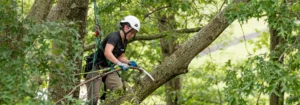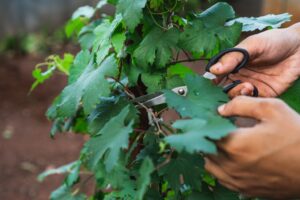Protecting Your Trees: Common Threats and Solutions in Richmond, VA
Maintaining the health of trees in Richmond, VA is essential for several reasons. Beyond the aesthetic appeal they bring to the city, trees play a crucial role in environmental sustainability, property value, and personal well-being. Richmond boasts a diverse urban forest, comprising a multitude of species ranging from towering oaks to delicate dogwoods. This rich tapestry of greenery not only enhances the city’s charm but also contributes to its ecological balance by providing habitat for wildlife, improving air quality, and mitigating the urban heat island effect.
However, the health and vitality of Richmond’s trees are under constant threat from various factors. In this article, we will explore some of the most common threats facing trees in the Richmond area and discuss practical solutions for addressing them. By understanding these challenges and taking proactive steps to mitigate them, we can ensure the long-term health and resilience of Richmond’s urban forest.
Common Threats to Tree Health in Richmond, VA
Pests and Diseases
One of the primary challenges confronting tree health in Richmond is the onslaught of pests and diseases. The city is home to a multitude of tree species, each vulnerable to its unique set of threats. Among the most notorious pests is the emerald ash borer (Agrilus planipennis), an invasive beetle that has decimated ash trees across North America. In Richmond, ash trees are particularly at risk, with devastating consequences for both urban landscapes and forested areas.
Another significant threat is oak wilt (Ceratocystis fagacearum), a fungal disease that targets oak species. Oak wilt disrupts the flow of water and nutrients within the tree, leading to wilting, defoliation, and eventual death. The disease spreads rapidly through interconnected root systems or via sap-feeding beetles, posing a serious risk to Richmond’s iconic oak trees.
In addition to these headline-grabbing pests and diseases, a myriad of other pathogens and insects threaten the health of Richmond’s trees. These include fungal infections like anthracnose and powdery mildew, as well as insect pests such as the gypsy moth and the hemlock woolly adelgid. Left unchecked, these threats can wreak havoc on the urban forest, causing widespread tree decline and loss.
Climate and Environmental Factors
Richmond’s climate presents its own set of challenges for tree health. With hot, humid summers and cold, wet winters, the city experiences a wide range of weather extremes throughout the year. These fluctuations can stress trees, making them more susceptible to pests, diseases, and environmental damage.
Extreme temperatures, whether scorching heat or freezing cold, can take a toll on tree health. Heat stress can cause leaf scorch, wilting, and premature leaf drop, while cold snaps can damage tender buds and bark. Additionally, prolonged periods of drought can deprive trees of essential moisture, leading to wilting, leaf loss, and even death in severe cases.
Severe weather events, such as storms, hurricanes, and ice storms, pose another significant threat to tree health in Richmond. High winds, heavy rain, and ice accumulation can cause branches to break, trunks to split, and entire trees to uproot. These events not only damage individual trees but can also result in widespread tree mortality and property damage.
Human Activities
Human activities also play a significant role in tree health, often exacerbating existing threats or creating new ones altogether. Construction projects, for example, can disrupt soil structure and compaction, leading to root damage and reduced nutrient uptake. Excavation and trenching near tree roots can sever critical root systems, compromising tree stability and health.
Improper tree care practices, such as incorrect pruning techniques or overzealous trimming, can also harm trees. Improper cuts can create entry points for pathogens and insects, while excessive pruning can stress trees and disrupt their natural growth patterns. Similarly, neglecting routine maintenance tasks like watering, mulching, and fertilizing can leave trees vulnerable to pests, diseases, and environmental stressors.
How to Address These Threats
Prevention Measures
Prevention is often the most effective strategy for safeguarding tree health in Richmond. By implementing proactive measures, property owners can reduce the risk of pest infestations, disease outbreaks, and environmental damage. Regular tree inspections by certified arborists are a crucial component of preventive care, allowing early detection of potential issues before they escalate.
Proper tree selection is also key to preventing problems down the line. Choosing native or adapted species that are well-suited to Richmond’s climate and soil conditions can increase tree resilience and reduce the need for intensive maintenance. Additionally, selecting pest-resistant varieties can help mitigate the risk of infestation and disease.
Good cultural practices, such as proper planting techniques, mulching, and watering, can further support tree health and vitality. Mulching helps retain soil moisture, regulate soil temperature, and suppress weed growth, while watering during periods of drought can prevent stress and dehydration. Applying organic mulch around the base of trees also enriches the soil, providing essential nutrients for healthy growth.
Early Detection and Treatment
Despite best efforts at prevention, threats to tree health may still arise. Early detection is therefore crucial for effective management and control of pests, diseases, and environmental stressors. Property owners should familiarize themselves with the signs and symptoms of common tree ailments, such as unusual leaf discoloration, wilting, and dieback.
Regular monitoring of trees for signs of distress allows for timely intervention, potentially saving valuable specimens from decline or death. If problems are detected, property owners should consult with a certified arborist or tree care professional for diagnosis and treatment recommendations. Depending on the nature and severity of the issue, treatment options may include targeted pesticide applications, fungicide treatments, or cultural interventions.
Professional Tree Care Services
Engaging the services of a professional tree care company is an investment in the long-term health and beauty of Richmond’s urban forest. Certified arborists possess the expertise, experience, and equipment necessary to assess tree health accurately and implement appropriate interventions. They can conduct comprehensive tree inspections, diagnose problems, and develop customized treatment plans tailored to the specific needs of each tree.
Professional tree care companies also offer a wide range of services to support tree health and vitality. These may include pruning, tree removal, stump grinding, fertilization, and pest management. By entrusting tree care tasks to qualified professionals, property owners can ensure the safety, health, and beauty of their trees for years to come.
Conclusion
Protecting the trees of Richmond, VA is a responsibility that falls on all of us. By understanding the common threats facing our urban forest and taking proactive steps to address them, we can ensure the long-term health and resilience of our trees. Whether it’s through preventive measures, early detection and treatment, or professional tree care services, there are numerous ways that individuals can contribute to the preservation of Richmond’s green legacy.
As stewards of our urban environment, it is incumbent upon us to prioritize tree health and take action to protect our valuable natural resources. By working together and investing in the care and maintenance of our trees, we can ensure that future generations will continue to benefit from the many ecological, aesthetic, and economic contributions that trees provide to our city.
In conclusion, let us all commit to caring for Richmond’s trees and preserving the beauty and vitality of our urban forest for generations to come. Whether it’s planting a new tree, scheduling a tree inspection, or supporting local tree care initiatives, every action we take helps to safeguard the health and well-being of our beloved trees and the communities they enrich. Together, we can ensure that Richmond remains a vibrant, green oasis for years to come.
Tree Trimming Richmond
(804) 533-3943
https://treetrimmingrichmond.com/



